|
|
| Cascitello |
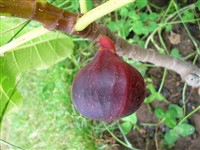
This fig tree is present in the South of Italy in the Lecce Province, Salento, where it is considered among the best variety both for its heavy breba and main crop production.
Cascitello is a quite demanding fig tree and must be planted in a well prepared soil in order to ensure that the plants grows strongly, otherwise there is a strong likelihood that Cascitello will produce tiny fruits of poor quality. One must not hesitate to move Cascitello somewhere else in the garden, if growth is insignificant.
On the other hand, when Cascitello is pleased with its location, the tree grows fast and usually produces breba and main crop fruits the very first year. The growth habit is erected and the leaves are light green.
The cold resistance is quite good, however, Cascitello requires a sheltered position (south facing) and some wind protection (house or wall).
The brebas fruit production is abundant, however the tree is sensitive to temperature variations in spring, which can make fruits drop. Due to the exceptional quality of this fig, and in order not to lose the entire crop, keeping the tree small (adequate trimming) helps protect the tree in case of cold nights.
As a matter of facts, as soon as night temperatures fall beneath 5°C, the use of a wooden removable sight break arranged around the tree plus a top cover made of wintering veil give good results. This protection must be removed as soon as the night temperature raises again.
The breba fruit is really rich and posseses a complex fruity savor. The fruit melts in the mouth, is honey-like with fruity organoleptic notes of banana and black mulberry plus something unique to Cascitello. The fruit skin is very thin and very sweet but when fully ripe, the fruit skin cracks which means that it is time to savor Cascitello. Heavy summer rains may wash away the high sugar rate.
The main crop fruits are very similar to the breba ones, though the fruits are somehow smaller, but sweeter. During a warm fall and even after some heavy rains, the sugar rate of the main crop remains high. The main crop is early.
In Lecce, the main crop may be caprified (pollinated) on purpose to produce dry figs. These fruits are of medium size, have crunchy seeds and are named “Schiavoni”.
However, when the main crop is not caprified, the fruits are used mainly for family consumption. These fruits are slightly smaller than the “Schiavoni” and are named “Canibianchi”. These are the only fruits that can be produced outside of the natural fig area.
Cascitello is somehow a capricious fig tree that may be difficult to settle down, which requires a light protection in spring in order to get a significant breba crop and which produces a regular, early and quite abundant main crop. The fruits have a delicate and unique perfume.
Under proper cultivation, this fig is an absolute winner.
|
| |
| General data |
| Origin |
Italy, Puglie |
| Synonym(s), local names |
Casciteddha, Cascella, Cascetta, Banegra, Colummo, Colombo, San Pietro, Schiavone, Schivone, Niuro, Canibianco, Canibianchi, Mario, Mariu, Napulitanu |
| Tree type |
Common |
| Crop |
Biferous |
| |
| Tree morphological characteristics |
| Shape |
Erected |
| Vigor |
Medium |
| Ability to produce suckers |
Weak |
| Height after 10 years |
250 cm |
| Width after 10 years |
400 cm |
| Minimum width |
400 cm |
| |
| Branch morphological characteristics |
| Branch color |
Brown yellow |
| Caliber |
Medium |
| Buds |
Pinky |
| |
| Leaves morphological characteristics |
| Leaves |
Average |
| Lobs |
3-5 |
| Depth |
Medium sinuses |
| |
| Adaptation outside the Mediterranean area |
| Cold hardiness |
Good |
| Wind resistant |
Good |
| Pot culture |
Very good |
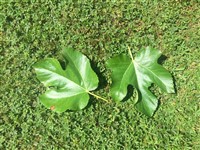
| Yield |
Good |
| Fruits dropping |
High fruit drop |
| Alternance |
Weak |
| Sensitivity to splitting |
Resistant |
| Crop begin date (day-month) |
Valleiry:25-07 |
| |
| External characteristics |
| Skin color |
Violet, orange |
| Skin thickness |
Very thin |
| Shape |
Pyriform flattened |
| Stalk |
Breaks off readily |
| Stalk shape |
Short and thick |
| Neck |
Short |
| Neck color |
Green, brown |
| Eye |
Big, opened |
| Eye color |
Green, brown-violet |
| Average weight (grams) |
75 g - 90g |
| |
| Internal characteristics |
| Pulp color |
Amber |
| Seeds |
Not felt |
| |
| Organoleptic evaluation |
| Texture |
Melts in the mouth |
| Sugar |
Sweet |
| Taste |
Excellent |
| Perfume |
Strong |
| Organoleptic descriptors |
Fruity, Banana, Black Mulberry, Honey |
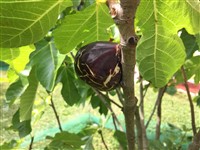 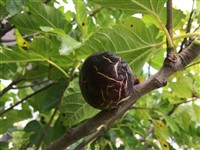 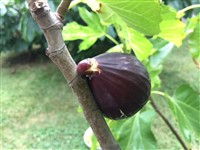 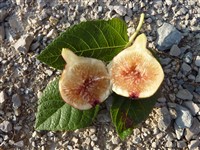
| Yield |
Strong |
| Fruits dropping |
No fruit drop |
| Alternance |
None |
| Sensitivity to splitting |
Resistant |
| Crop begin date (day-month) |
Valleiry:04-09 |
| |
| External characteristics |
| Skin color |
Brown, red |
| Skin thickness |
Thin |
| Shape |
Turbinate |
| Stalk |
Breaks off readily |
| Stalk shape |
Short and thick |
| Neck |
Very short |
| Neck color |
Red |
| Eye |
Medium, opened |
| Eye color |
Brown, violet |
| Average weight (grams) |
45 g |
| |
| Internal characteristics |
| Pulp color |
Light strawberry |
| Seeds |
Felt, few |
| |
| Organoleptic evaluation |
| Texture |
Melts in the mouth |
| Sugar |
Very sweet |
| Taste |
Excellent |
| Perfume |
Strong |
| Organoleptic descriptors |
Fruity, Black Mulberry, Dried fruits, Honey |
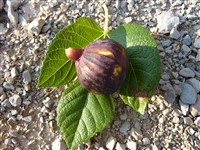 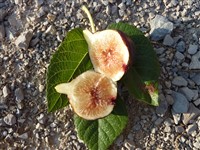 
|








